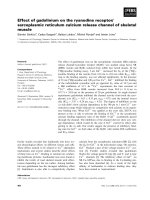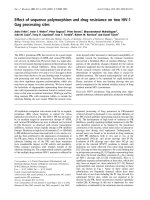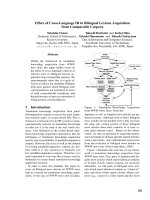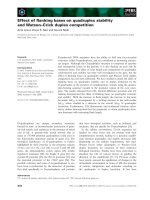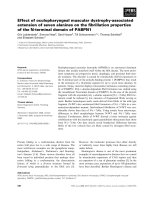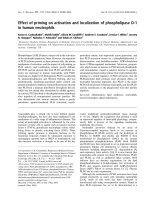Báo cáo khoa học: "Effect of Reproductive Status on In Vitro Developmental Competence of Bovine Oocytes" docx
Bạn đang xem bản rút gọn của tài liệu. Xem và tải ngay bản đầy đủ của tài liệu tại đây (140.04 KB, 6 trang )
J O U R N A L O F
Veterinary
Science
J. Vet. Sci. (2003), 4(1), 67-72
Abstract
10)
The objectives of the present study were to
compare the
in vitro
maturation (IVM), fertilization
and early embryonic development of bovine oocytes
recovered from ovaries during the follicular, met-
estrus and diestrus stages of the estrous cycle and at
anestrus and pregnancy after maturation in a serum
free culture medium. Cumulus oocyte complexes
(COCs) collected from ovaries at different repro-
ductive statuses w ere matured in m edium 199
supplem ented w ith 10 g/ml FSH, 10 g/ml LH, 1.5 g/m
estradiol, 75 g/ml streptomycin, 100 IU/ml penicillin
and 10 mM HEPES. COCs w ere incubated in 200
㎕
droplets of maturation medium 199 under oil for 24 h
at 39
℃
and 5% CO2. Matured oocytes w ere exposed to
frozen-thaw ed TALP sw im up, heparin capacitated
sperm from tw o bulls separately in each replicate (20
h, 39C, 5% CO2). After fertilization, the presumptive
zygotes w ere cultured in medium 199 containing 8
mg/ml BSA-V, 100 IU/ml penicillin-G, 75 g/ml strept-
omycin and 10 mM HEPES for 144 h at 39C and 5%
CO2 w ithout medium freshening or change. Oocy-
tes/embryos w ere fixed, stained w ith DAP I and
evaluated under fluorescent microscope. The IVM
rates w ere almost sim ilar among oocytes from all
reproductive statuses (range: 89.8 to 95.4%). How ever,
IVM rates for oocytes from the metestrus (90.6%) and
pregnant (89.9%) phases w ere low er than the other
groups. The fertilization rates w ere low er (p<0.05) for
oocytes from the diestrus phase (72.4%) than from the
other phases (range : 81.1 to 86.6%). Oocytes, recovered
during the metestrus phase of the estrous cycle,
resulted in the highest cleavage rate (60.0%), w hile
oocytes from the diestrus phase had the poorest
embryonic development (39.8%: p<0.05). Majority of
the embryos from all reproductive phases show ed a
* Corresponding Author: Kazim R. Chohan
Andrology and IVF Laboratories, University of Utah Health Sciences
Center, 675 Arapeen Dive, Suite 205 Salt Lake City, UT 84108, USA
E-mail:
developmental arrest around 8-cell stage. Although
the developmental competence of oocytes from
pregnant and anestrus animals w as low er than that
from the other reproductive stages, they could be
potentially used as oocyte donors. Long term,
in vitro
embryo culture without medium freshening or change
w as hypothesized to have caused the failure to
overcome the 8-cell block to development.
Key words
: bovine, reproductive, status, oocyte, IVMFC.
Introduction
Much of the current interest in the commercial appli-
cation of in vitro fertilization (IVF) in cattle has been
focused on laproscopic, surgical or ultrasound guided trans-
vaginal collection of oocytes from follicles of cows in active
production as a basis for producing additional embryos and
calves and thus circumvent infertility. Ovaries obtained
from abattoir still constitute an economical source of oocytes
for commercial and research purpose but their quality is
highly variable. There is still a clear difference in the
developmental competence of the ova obtained from in vivo
maturation and oocytes matured in vitro. The oocytes re-
covered from abattoir ovaries for in vitro embryo production
are extremely heterogeneous in terms of quality and de-
velopmental competence [9]. A reduction in variability of the
oocyte quality becomes more important when they are
selected as recipients for nuclear transfer or when in vitro
produced zygotes are used for pronucleus injection with
foreign DNA. As the oocytes used for IVF are commonly
recovered from slaughter house materials, the origin of the
ovaries and the reproductive status of the animals are
usually unknown. These variations in oocyte quality may be
due to differences in the reproductive stage of the sl-
aughtered animals.
Variable results have been described for IVM, ferti-
lization and subsequent embryonic development for the
oocytes collected from ovaries at different stages of repro-
duction [1, 4, 11, 13, 20]. The developmental competence of
fertilized oocytes can be greatly enhanced by supple-
mentation of maturation and culture medium with serum
Effect of Reproductive Status on In Vitro Developmental Competence of Bovine
Oocytes
Kazim R. Chohan* and Alan G. Hunter
Division of Theriogenology, College of Veterinary Medicine University of Minnesota, Saint Paul, MN 55108, USA
Received November 19, 2002 / Accepted February 11, 2003
68 Kazim R. Chohan and Alan G. Hunter
and/or culture of the zygotes following IVF, in conditioned
media or coculture with different somatic cells [10]. Serum,
included in maturation and embryo culture medium, allows
improvement in oocyte quality and better embryonic
development. However, heavier and abnormal calves [27]
and lambs [22] from in vitro produced embryos have
resulted in dystocia and have diverted the interest to
culturing embryos under serum free conditions. Periodic
renewal of culture medium has been reported detrimental to
embryonic development by removing embryo derived growth
factor(s), changing pH and gas atmosphere and lowering the
temperature of culture medium [6]. Considering these
factors, oocytes/zygotes from different reproductive statuses
were cultured under serum free culture conditions without
any medium renewal to observe their maximum develop-
mental potential. The present study also described the best
estrous stage for yielding quality oocytes, embryogenesis
relative to different reproductive statuses and the feasibility
of using oocytes from anestrus and pregnant cows to
produce calves using IVF procedures.
Materials and Methods
Bovine ovaries were immediately collected after slaughter
and classified into different phases of the estrous cycle
(follicular, metestrus and diestrus), anestrus and pregnancy
[28]. COCs were aspirated from follicles of 2 to 6 mm in
diameter with an 18 gauge needle fitted to a 12 ml dis-
posable syringe. Oocytes possessing a full cumulus mass,
unfragmented cytoplasm and intact zona were washed
thrice and incubated in 200
㎕
drops (5 to 8 oocytes/drop) of
maturation medium M199 under sterile mineral oil in 60 x
35 mm sterile plastic dishes at 39
℃
and 5% CO2 in air for
24 h. The maturation medium was TCM199 with Earle's
salts, 100 mg/l glutamine and 2.2 g/l NaHCO3 (Celox Corp.,
MN) supplemented with 10 g/ml FSH, 10 g/ml LH, 1.5 g/ml
estradiol, 75 g/ml streptomycin, 100 IU/ml penicillin and 10
mM HEPES (N-[2-Hydroxyethyl]piperzineN-2[2ethanesul-
fonic acid]). All media were filtered through 0.2
㎛
acrodisc
filters (Gelman Sciences, Ann Arbor, MI). Unless specified,
the reagents were cell culture tested and were from Sigma
Chemicals, Saint Louis, MO, USA.
TALP swim up procedure was used for sperm preparation
[15]. The composition of TALP was 99.0 mM NaCl, 3.1 mM
KCl, 25.0 mM NaHCO3, 0.35 mM NaH2PO4, 2.0 mM CaCl2,
1.1 mM MgCl2, 6H2O, 21.6 mM DL-lactic acid, 1.0 mM Na
pyruvate, 6.0 mg/ml BSA-V, 10 mM HEPES and 100 mg/ml
penicillin G. The pH of TALP was adjusted to 7.4. Frozen
semen from two bulls was used separately in each replicate
to fertilize the oocytes. The reason for using semen from two
different bulls was to rule out the possible effects of poor
quality semen on IVF parameters by using semen from a
single bull. Sperm frozen in milk extender were thawed at
35
℃
for 30 sec and 0.20 to 0.25 ml aliquots were layered
under 1.5 ml of 39
℃
TALP in 15 ml centrifuge tubes using
a 21 gauge needle attached to a 1 ml sterile disposable
syringe. The samples were incubated at 39
℃
in an
atmosphere of 5% CO2 in air for 1 h. The upper 1 ml was
collected, pooled into a new 15 mL centrifuge tube and
centrifuged at 100 g for 10 min. The pellet was resu-
spended with 1 ml TALP and then allowed to stand at 22
℃
for 5 min. An additional 3 ml TALP was added to the sperm
suspension and centrifuged at 100 g for 10 min. The
supernatant was pipetted off and the sperm pellet was
resuspended in the remaining fluid (~100
㎕
). This sperm
suspension was diluted 1:1 with heparin solution (70 units
in 2.5 ml TALP) and incubated for 15 min at 39
℃
and 5%
CO2. Matured COCs were washed twice in TALP and 5
COCs were transferred to each droplet of 40
㎕
TALP
droplet under mineral oil that had been equilibrated
overnight at 39
℃
in a humid atmosphere of 5% CO2.
Heparin capacitated sperm suspension was added to the
droplets to achieve a final sperm concentration of 1
×
106/
㎖
. The sperm and oocytes were coincubated at 39
℃
and 5%
CO2 for 18 to 20 h.
After fertilization, the presumptive zygotes were washed
twice and cultured in 200
㎕
droplets (5 to 8/drop) of
medium 199 containing 8 mg/ml BSA fraction-V, 100 IU/ml
penicillin-G and 75 g/ml streptomycin for 144 h at 39
℃
and
5% CO2 without any serum supplementation or medium
change. After culture, oocytes/embryos were fixed in 430
mM glutaraldehyde and incubated in 0.029 mM 4, 6 dia-
midoino-2-phenylindole (DAPI), a fluorescent stain specific
for nuclear material for 20 min. They were then rinsed,
mounted on slides and evaluated for the stage of nuclear
maturation, fertilization and cleavage development at 400 X
using a Zeiss inverted microscope equipped with fluorescent
illumination and filters giving maximum transmittance at
405 nm. The data were analyzed using the chi square test
for the difference (p<0.05) between bulls and among
different reproductive statuses for maturation, fertilization,
polyspermy, cleavage and degeneration rates [19].
Results
The results of present study are shown in Table 1. No
difference (p>0.05) was found for any parameter between
the two bulls used in the present investigation (data not
shown). The maturation rates (oocytes reaching metaphase-
II) were lower for oocytes from ovaries at metestrus (90.6%)
or from pregnant phase (89.8%) than from follicular (93.2%),
diestrus (95.4%) and anestrus (92.2%) phases. The overall
fertilization rates were lowest for oocytes from the diestrus
phase (72.4%) than for oocytes from other reproductive
statuses (range: 81.1 to 86.6%). Oocytes from the metestrus
phase of the estrous cycle resulted in the highest (p<0.05)
cleavage rates (60%), whereas oocytes from the diestrus
phase showed poorest cleavage rates (39.8%). The sub-
sequent embryonic development was significantly higher for
oocytes from the follicular and metestrus phases. However,
Effect of Reproductive Status on In Vitro Developmental Competence of Bovine Oocytes 69
the majority of the oocytes in all reproductive phases were
blocked at the 8-cell stage (Fig. 1). Polyspermic fertilization
was less in follicular (1.0%) and metestrus (1.3%) phases
than in diestrus (2.6%), anestrus (3.7%) and pregnant (2.5%)
phases. The degeneration rates ranged between 4.6 to 10.5%
among all the reproductive phases.
Discussion
The study presented here indicates the possibility of
predicting the developmental competence of an oocyte based
on reproductive status of the animal from which the ovary
was collected. No difference (p>0.05) for any parameter was
observed with the semen used from two different bulls.
Semen from two different bulls was used separately in each
replicate to rule out the possible effects of poor quality
semen on IVF parameters by using semen from a single
bull. These results showed that both bulls had similar
fertilizing ability. The maturational competence of oocytes
for IVM was not influenced by the reproductive status.
However, fertilization and subsequent embryonic develop-
ment rates differed relative to reproductive status (p<0.05).
Oocytes collected during metestrus phase of the estrous
cycle resulted in the best cleavage rate (60%) followed by
those from the follicular phase (51.7%). Oocytes from the
diestrus phase showed the poorest fertilization as well as
embryonic development. No difference for maturation, fer-
tilization and cleavage rates was observed for oocytes
collected during different stages of the bovine estrous cycle
[1, 12, 20]. However, Varisanga et al., [26] suggested that
oocyte yield, cleavage rate and subsequent embryo develo-
pment is a function of ovarian morphological status, which
in turn is dependent on the stage of estrous cycle of the cow.
Higher embryonic development for oocytes recovered between
Table 1.
In vitro maturation, fertilization and cleavage rates of bovine oocytes relative to reproductive status
Reproductive
Status of Ovary
Total
Oocytes
Maturation
Rate
Overall
Fertilization
Cleavage
Rate
Degeneration
Rate
Polyspermic
Fertilization
Percentage
Follicular 292 93.2a 82.9a 51.7a 6.5a 1.0a
Metestrus 307 90.6b 86.6a 60.0b 9.5bc 1.3ab
Diestrus 304 95.4a 72.4b 39.8c 4.6a 2.6ab
Anestrus 245 92.2a 86.1a 44.1ac 7.8ab 3.7b
Pregnant 286 89.8b 81.1a 46.9ac 10.5c 2.5ab
abcd Denote difference (p<0.05) within columns.
Data shown are percentages, based on 8 replicates.
0
10
20
30
40
50
60
Follicular Metestrus Diestrus Anestrus Pregnant
b
c
a
a
a
a
b
a
a
a
a
a
b
a
2
-
8 Cells 9
-
16 Cells 17
-
64 Cells
a
(%)
Fig. 1.
Developmental competence of fertilized oocytes relative to reproductive status.
*
Different letters on bars indicate significant differences (p<0.05).
70 Kazim R. Chohan and Alan G. Hunter
days 14 to 16 of the estrous cycle than at days 7 to 9 or at
unknown stages also showed that stage of the estrous cycle
influenced the in vitro developmental competence of bovine
oocytes [13]. Knuth and Hunter [11] reported a decrease in
fertilization rate for oocytes from the ovary bearing a mature
corpus luteum compared with those bearing a maturing
corpus luteum (54% vs 61%) or without a corpus luteum
(71%). Low cleavage rates for bovine oocytes from ovaries
bearing a corpus luteum (75%) compared to ovaries bearing
no corpus luteum (85%) were also observed [4]. The reasons
for such differences are at present unclear. However, wave
pattern in follicular development or the intrafollicular
environment, to which oocytes are exposed, may be the factors
effecting variability in developmental competence of bovine
oocytes.
Present results for variable fertilization and cleavage
rates at different reproductive phases (follicular, metestrus
and diestrus) are supported by the observations that small
and medium size follicles contained high estradiol concent-
rations in the early days (1-10) of the estrous cycle
compared with the late (days 11-17) luteal phase [18]. These
findings indicated that small follicles in mid luteal phase
were more likely to be atretic than those present in the
early luteal phase. The better results during the metestrus
phase in the present study may be due to the isolation of
oocytes from a new emerging follicular wave after ovulation
consisting of more healthy oocytes than other phases of the
estrous cycle. The development of a dominant follicle is
closely associated with the regression of subordinate fol-
licles. However, better development rates for follicular phase
oocytes than diestrus might be explained by the findings of
Smith et al., [17]. Their data suggested that in cattle, the
developmental competence of oocytes from small antral
follicles was not adversely affected by the presence of a
dominant follicle. Gandolfi et al. [7], also reported that the
presence of a dominant follicle had no effect on IVM,
fertilization and subsequent embryonic development of
bovine oocytes. The reason for poor developmental rates for
oocytes from the diestrus phase in the present study, may
be due to the collection of oocytes from a cohort of small
atretic follicles of the first or second wave of follicular
development.
The development results for oocytes collected during
pregnant and anestrus phase are poor but they are still
high enough to be considered for in vitro production of
embryos. Behboodi et al. [3] reported a 38% cleavage rate
for oocytes collected from pregnant cows compared to 40%
for those from non-pregnant animals. Similar cleavage rates
were also observed [24] for oocytes harvested from pregnant
(48%) and non-pregnant cow ovaries (51%). These cleavage
rates are very close to the present findings presented in
Table I. However, Sivakumaran et al. [16] found higher
cleavage rates (72%) for oocytes from pregnant cow ovaries
than from the ovaries at diestrus (69%) and anestrus (59%)
phases. Ovaries from pregnant cows have been reported to
be a source for high quality oocytes with great develop-
mental competence [14]. This may be due to high pro-
gesterone levels in the circulation resulting in the
regression of dominant follicle and emergence of constant
follicle wave turnover [21]. The reasons for poor in vitro
developmental competence of oocytes from the anestrus
phase can be attributed to the poor body condition,
environment, season, lactation, stress and age of the donor
animals resulting in poor ovarian activity. Similar factors
were responsible for poor IVM, fertilization and em-
bryogenesis for oocytes derived from bovine ovaries having
less than 10 follicles of 2 to 5 mm in diameter compared to
oocytes from ovaries bearing a single follicle of > 10 mm or
the presence of more than 10 follicles of 2-5 mm in diameter
[7]. Varisanga et al. [26] also observed poor in vitro
development for oocytes from ovaries bearing no active
strucure, i.e., a dominant follicle or corpus luteum.
Although satisfactory maturation and fertilization rates
were obtained in the present study under serum free culture
conditions, embryonic development was affected without
medium renewal or serum supplementation during embryo
culture. Majority of the embryos showed a developmental
arrest around the 8-cell stage from all the reproductive
phases. In contrast, Fukui et al. [6] reported the highest
rates of blastocyst formation (37.6%) without medium
renewal. This difference may be due to medium selection
because they utilized synthetic oviductal fluid medium
(SOF) supplemented with glutamine, amino acids and
human serum compared to TCM199 supplemented with only
BSA as protein source in the present study. These results
indicated that culture conditions employed in the present
study were not suitable for embryo development. Eyestone
and First [5] reported that development arrest around 8 to
16 cell stage in bovine oocytes was not due to embryonic
death but rather to some sublethal flaws acquired during in
vitro culture. The present data are not sufficient to draw
any significant conclusions. However, it supports the previous
findings that renewal of medium every 48 hours during in
vitro culture to avoid ammonium toxicity is beneficial [8,
23]. Several studies suggested that serum factors are
required to protect embryos against the toxicity of oxygen
and heavy metals or other deleterious components of in
vitro culture media and periodic addition of serum before
the 8 to 16 cell stage accelerated embryo development [2, 25].
In summary, the results of present study revealed that
selection of oocytes relative to reproductive status is a
useful parameter for better in vitro development rates.
Oocytes from pregnant and anestrus cows, could be utilized
by ultrasound guided transvaginal aspiration to produce
additional embryos and calves from genetically superior
animals. Bovine oocytes can be successfully matured in vitro
under serum free culture conditions. Long term in vitro
culture without medium freshening or change is hypo-
thesized to have caused the failure to overcome the 8-cell
stage block to development in this study.
Effect of Reproductive Status on In Vitro Developmental Competence of Bovine Oocytes 71
References
1.
Arlotto, T., Schwartz J. L., First, N. L. and
Leibfried-Rutledge, M. L.
Aspects of follicle and oo-
cyte stage that affect in vitro maturation and develop-
ment of bovine oocytes. Theriogenology. 1996,
45
,
943-956.
2.
Bavister, B. D.
Culture of preimplantation embryos:
facts and artifacts. Human Reproduction Update. 1995,
1
, 91-148.
3.
Behboodi, E., Anderson, G. B. and BonDurant, R.
H.
Development of in vitro fertilized oocytes from
pregnant and non pregnant cows in oviductal epithelial
and cumulus cell co-culture systems. Theriogenology.
1992,
38
, 1077-1084.
4.
Boediono, A., Rajamagendran, R., Saha, S.,
Sumantri, C. and Suzuki, T.
Effect of presence of CL
on ovary on the oocyte number, cleavage rate and
blastocyst production in vitro in cattle. Theriogenology.
1995,
43
, 169.
5.
Eyestone, W. H. and First, N. L.
Characterization of
developmental arrest in early bovine embryos cultured
in vitro. Theriogenology. 1991,
35
, 613-624.
6.
Fukui, Y., Lee, E. S. and Akari, N.
Effect of medium
renewal during culture in two different culture systems
on development to blastocysts from in vitro produced
early embryos. J. Anim. Sci. 1996,
74
, 2752-2758.
7.
Gandolfi, F., Luciano, A. M., Modina, S., Ponzini,
A., Pocar, P., Armstrong, D. T. and Lauria, A.
The
in vitro developmental competence of bovine oocytes can
be related to the morphology of the ovary. Theriogenology.
1997,
48
, 1153-1160.
8.
Gardner, D. K., Lane, M., Spitzer, A. and Batt, P.
A.
Enhanced rate of cleavage and development for
sheep zygotes cultured to the blastocyst stage in vitro
in the absence of serum and somatic cells: amino acids,
vitamins and culturing embryos in groups stimulate
development. Biol. Reprod. 1994,
50
,390-400.
9.
Gordon, I. and Lu, K. H.
Production of embryos in
vitro and its impact on livestock production. Therio-
genology. 1990,
33
, 77-87.
10.
Gordon, I.
Laboratory production of cattle embryos.
Biotechnology in Agriculture No. 11. CAB International
UK, 1994.
11.
Knuth, K. M. and Hunter, A. G.
Effects of a corpus
luteum and source of mineral oil overlay on in vitro
maturation and fertilization of bovine oocytes. J. Dairy
Sci. 1996,
79
(Suppl-I),147.
12.
Leibfried-Rutledge, M. L., Crister, E. S. and First,
N. L.
Fertilization potential of follicular oocytes classified
by stage of cycle and size of follicle. Theriogenology.
1985,
3
, 753-759.
13.
Machatkova, M., Jokesova, E., Petelikova, J. and
Dvoracek, V.
Developmental competence of bovine em-
bryos derived from oocytes collected at various stages of
the estrus cycle. Theriogenology. 1993,
45
, 801-810.
14.
Moreno, J. F., Flores-Foxworth, G., Westhusin, M.
and Kraemer, D. C.
Influence of pregnancy and pre-
sence of a CL on quantity and quality of bovine oocytes
obtained from ovarian follicles aspirated post-mortem.
Theriogenology. 1993,
39
,271.
15.
Parrish, J. J., Susko-Parrish, J. L., Leibfried-
Rutledge, M. L., Crister, E. S., Eyestone, W. H. and
First, N. L
. Bovine in vitro fertilization with frozen
thawed semen. Theriogenology. 1986,
25
,591-600.
16.
Sivakumaran, K., Calder, M. and Rajamahendran,
R.
The influence of reproductive status of bovine on
oocyte number and maturation in vitro and the effect of
coculture systems on fertilization and subsequent de-
velopment. J. Anim. Sci. 1991,
69
(Suppl.), 438.
17.
Smith, L. C., Olivera-Angel, M., Groome, N. P., B.
Bhatia, B. and Price, C. A.
Oocyte quality in small
antral follicles in the presence or absence of a large
dominant follicle in cattle. J. Reprod. Fertil. 1996,
106
,
193-199.
18.
Spicer, L. J. and Zinn, S. A.
Relationship between
concentration of cortisol in ovarian follicular fluid and
various biochemical markers of follicular differentiation
in cyclic and anovulatory cattle. J. Reprod. Fertil. 1987,
81
, 221-226.
19.
Stat View 5.1 Program.
Abacus Concepts, Stat View
Inc., Berkley, CA, 1994.
20.
Tan, S. J. and Lu, K. H.
Effects of different oestrus
stages of ovaries and sizes of follicles on generation of
bovine embryos in vitro. Theriogenology. 1990,
33
,335.
21.
Taylor, C. and Rajamahendran, R.
Effect of mid
luteal phase progesterone levels on the first wave
dominant follicle in cattle. Can. J. Anim. Sci. 1994,
74
,
281-285.
22.
Thompson, J. G., Gardner, D. K., Pugh, P. A.,
McMillan, W. H. and Trevit, H. R.
Lamb birth
weight is affected by culture system utilized during `
pre-elongation development of ovine embryos. Biol.
Reprod. 1995,
53
, 1385-1391.
23.
Trounson, A. O., Pushett, D., Maclellan, L. J.,
Lewis, I. and Gardner, D. K.
Current status of
IVM/IVF and embryo culture in humans and farm
animals. Theriogenology. 1994,
41
, 57-66.
24.
Vajta, G., Machaty, Z., Barandi, Zs. and Varga, Zs.
Embryos derived from the in vitro fertilization of
oocytes of pregnant cows. Theriogenology. 1992,
37
,
811-815.
25.
Van Langendonckt, A., Donny, I., Schuurbiers, N.,
Auquier, P., Carolan, C., Massip, A. and Dessy, F.
Effects of supplementation with fetal calf serum on
development of bovine embryos in synthetic oviduct
fluid medium. J. Reprod. Fert. 1997,
109
, 87-93.
26.
Varisanga, M. D., Sumantri, C., Murakami, M.,
Fahurdin, M. and Suzuki, T.
Morphological classi-
fication of the ovaries in relation to the subsequent oo-
cyte quality for IVF produced bovine embryos. Therio-
genology. 1998,
50
, 1015-1023.
27.
Walker, S. K., Hartwitch, K. M. and Seamark, R.
F.
The production of unusually large offspring following
72 Kazim R. Chohan and Alan G. Hunter
embryo manipulation: concepts and challenges. Therio-
genology. 1996,
45
, 111-120.
28.
Zemjanis, R.
Diagnostic and Therapeutic Techniques
in Animal Reproduction. Williams and Wilkins Company,
Baltimore, MD, 1962.



